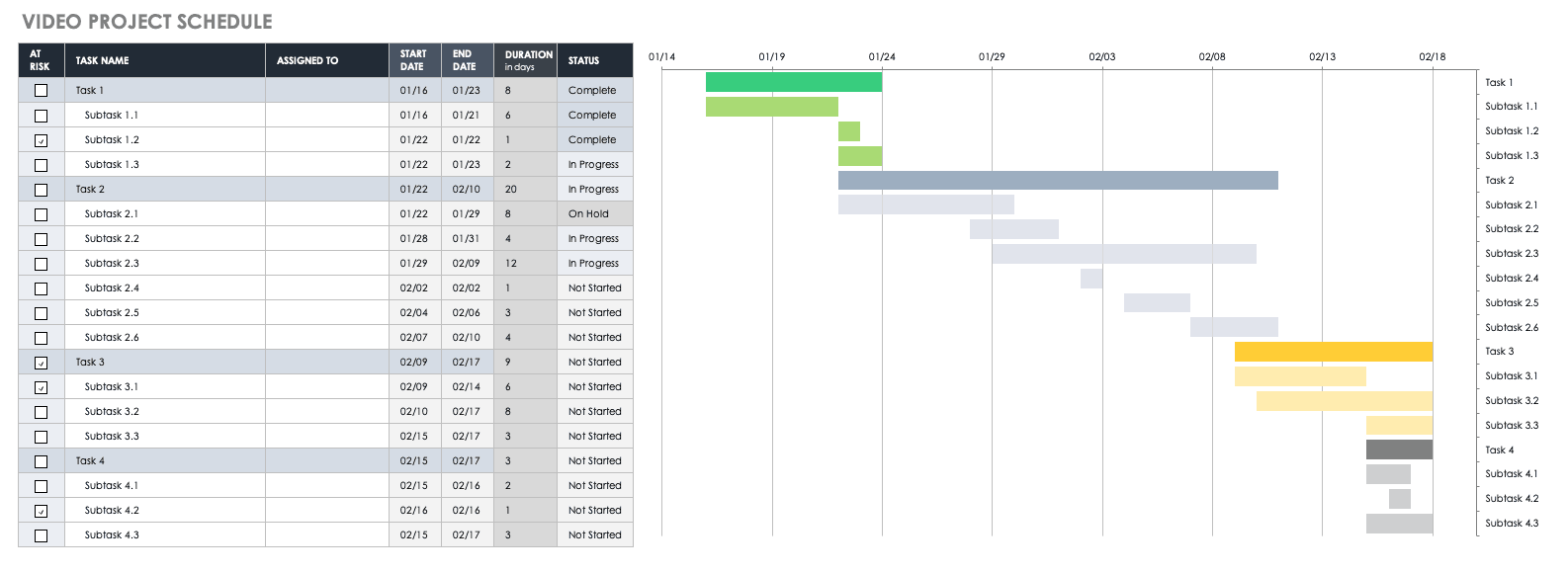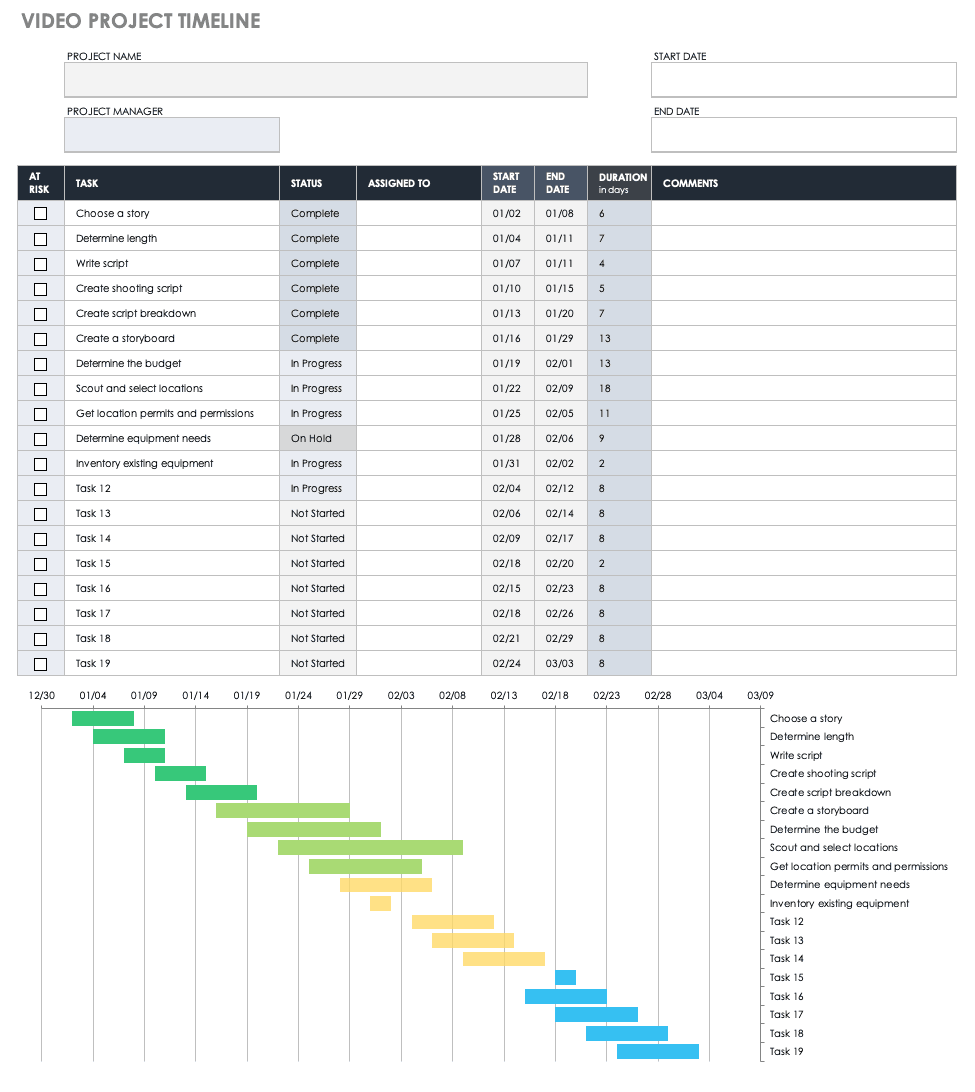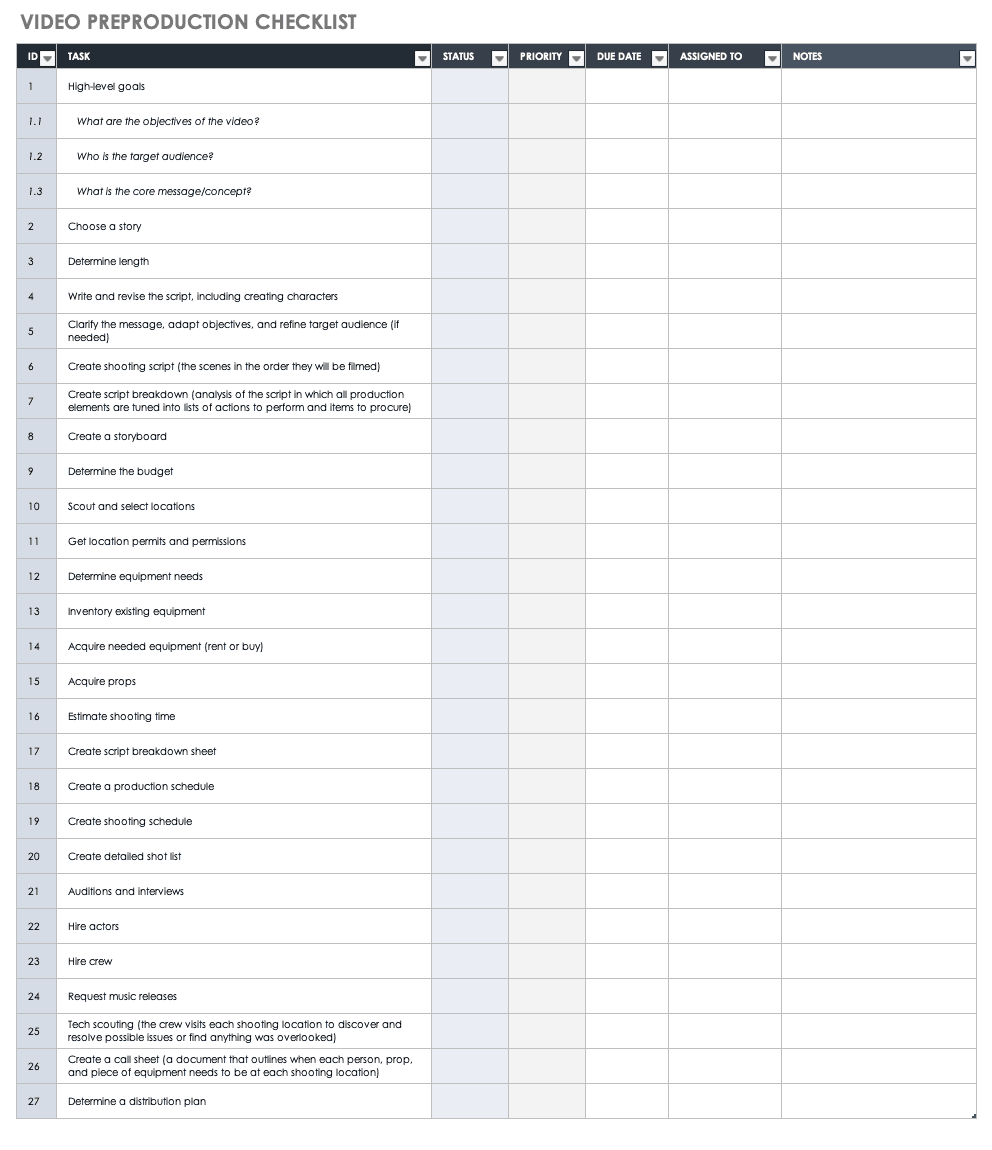What Is the Video Production Process?
Video production includes pre-production, production, and post-production. Pre-production involves planning, script-writing, securing financing, scouting locations, and hiring talent and crew. Production is that act of recording the video. Post-production involves video editing, wherein you also add special effects, music, and titles.
The Importance of Video Production Project Management
With the rise of YouTube (which is currently the second-most popular website) and other video-sharing sites in the last decade, video has become a common communication medium. Companies use video to make advertisements, how-tos, marketing materials, and more to get their message to the masses.
- 81 percent of business use video for marketing, according to Wyzowl. This ranges from large organizations like Nike and Heart Publications, to small business like your local bakery or bookstore.
- Cisco estimates video will be more than 80 percent of online traffic by 2022.
- 54 percent of people prefer video from brands they like, according to HubSpot.
- Insivia states that viewers retain 95 percent of the messaging they see in video, compared to 10 percent of what they read.
- A 2012 Comscore study found that over 85 percent of internet users watch video during a week.
How Do You Plan a Video Project?
A video project needs a plan, which you can use as a roadmap to deliver the project on time and on budget. Planning a video project requires not only traditional project management skills, but also knowledge of the intricacies of creating a video.
Below are some of the elements involved in a video marketing plan:
- Crew: This group can include a director, camera and sound people, production assistants, craft services, and other support staff.
- Talent: Talent includes anyone who works as a voiceover artist, actor, singer, dancer, and other type of performer. All talent will need to be audited and scheduled.
- Locations: This part of planning involves finding locations for shooting and then acquiring permission or permits to use the space. When production starts, all personnel (both talent and crew) and equipment have to be at the correct location at the right time. The many moving pieces make location scheduling even more critical than most projects.
- Editing, Sound, and Effects: After shooting and during post-production, a team pulls all the pieces together and adds elements to make it complete.
- Promoting and Distributing: These activities involve getting the finished product out into the world and noticed by viewers.
Video Project Schedule Template
Download this free template to track the progress of your video project from start to finish. You’ll be able to see the status of any task as well as a visual timeline of each phase. Easily track the budget of your video production and how spending matches up with estimates.
Download Video Project Schedule Template
Video Production Strategy
Having a solid high-level strategy will help guide the project and get it off to a successful start. The first step in developing a strategy is having a vision and reason for creating the video.
Adam Watstein is a Co-founder of Sharpshooter Pictures, a full-service video production company based in New York state. Watstein recommends having a strong idea of what the project should be.
“The vision of the story is definitely number one. If you don't have a vision, it’s because you don't know what your project is about. If you don’t have a strong opinion or strong voice, or aren’t ready to get this done, you're dead in the water. You have to believe in everything you're doing. The time to get inspired is during pre-production. If you can't find the inspiration, you need to keep working until you do. I've done jobs that are extremely tedious, but I find a reason to care. Maybe it's because the client has some kind of problem or something happened to them in the past that makes me feel really empathetic. Then I want to do something that's really going to make a difference to this person.”
Create the foundation for your video production by answering the following questions when starting the project:
- What is the goal of the video?
- How does the video relate to the company's strategy?
- Who is the target audience?
- What is the video format?
- Where will you distribute the video?
- How will you measure success and ROI?
Video Project Timeline Template
Download this free template to enter and track the steps in your video project. Enter a start and end date for each task, along with how long each should take to complete. Adjust the status to see which project are complete or on hold at a glance.
Download Video Project Timeline Template
What Are the Steps of Video Pre-production?
Pre-production includes planning and preparing to get everyone and everything ready to start shooting. The steps include finalizing the script, finding the crew, creating storyboards, scouting locations, casting, and developing a budget. Pre-production is the most important part of the process because it lays the groundwork for everything that follows.
Note that you may end up performing the steps below in a different order, and you may exclude some depending on the needs of the project.
Step 1: Determine High-Level Goals for the Video
First, discuss and agree upon the goals for the video with the production team. Below are some questions to answer at the start of the process:
- What are the objectives of the video?
- Who is the target audience?
- What is the core message/concept?
- Why are you making this video?
Step 2: Finalize the Script
Once the above decisions are made, more detailed determinations have to be made to ensure that the video will appeal to the target audience, meet the stated objectives, and communicate the core message.
This all begins with a script. When working on a script, you’ll want to do the following:
- Choose a story.
- Determine the length of the script (and therefore, the length of the video).
- Write and revise the script (this includes creating characters).
- Clarify the message, adapt objectives, and refine target audience (if needed).
- Write a shooting script (the scenes in the order they will be filmed).
- Do a script breakdown (analysis of the script in which all production elements are tuned into lists of actions to perform and items to procure).
- Create a storyboard.
Step 3: Determine the Budget
Video production can be expensive — from getting equipment for the shoot to paying staff. Decide how much you have to spend on the video; then create a budget and stick to it. Be sure to include a section for incidentals, as unexpected expenses always come up in video production.
Step 4: Location, Location, Location
Where will you shoot this video? Even if you’ll shoot in your office, you still need to reserve a designated space. Other locations may require permits and permissions and that can often dictate your shooting schedule.
Step 6: Make a Schedule
The first step in building a schedule is estimating the shoot time. If you plan on shooting outside, be sure to look at the forecast (if possible). Then, create a shoot schedule that includes a detailed shot list. Once that information is complete, you can start building your production schedule that includes everything from the start of your project to the finished video.
Step 7: Auditions and Interviews
At this point, you’re ready to staff your production, which includes auditioning and hiring actors and assembling a crew. Take care of signing any contracts with the actors or crew. You’ll also want to get any releases for music or talent that’s appearing in the video (for example, if you’re interviewing a CEO for a video series on your website, you’ll want them to sign a release).
Step 8: Preparing for First Day on the Set
Now that everything is in place, you’re ready to start making your video. However, there are a few things left to do to ensure everything runs smoothly. Do the following before calling everyone to the set:
- Perform a tech scout. The crew should visit each shooting location to discover and resolve possible issues or find anything was overlooked.
- Create a call sheet (a document that outlines when each person, prop, and piece of equipment needs to be at each shooting location).
- Determine a distribution plan.
Video Pre-Production Checklist
Download this free Excel checklist to ensure the completion of preprod tasks. It includes the basic pre-production steps, but you can also customize the template to meet the needs of your project.
Download a Video Pre-production Checklist
Excel | PDF | Smartsheet
Pre-Production Best Practices
At its core, pre-production is really all about planning and anticipating. Beth Pielert, a freelance producer and independent filmmaker based in the Bay Area, says, “Allow yourself enough time to think about everything and have contingencies so that you're really well-prepared.”
Below are some additional tips for video planning:
- Have a pre-production kickoff meeting to get all team members focused on the project’s goals.
- Create a written brief in which you describe the project. Then, use it to guide the overall approach.
- Batch scripts and shots to save time and money.
- Be prepared. Pielert advises, “Make sure your tools are working, and that you have some backup or contingency plans if something goes wrong. You need to build out a lot of resources for yourself, so that if something does go wrong, you know who to call.”
- After creating the storyboard, add a temporary soundtrack to help estimate the length of the video.
- Create a production schedule.
- Plan to include B-roll (extra footage that adds depth to a story, like a city skyline or an empty road, or reaction shots) and designate someone to shoot it.
- Focus on the flow of the story.
- Overestimate the time needed to complete the shoot.
- Block out and practice where you’ll place equipment during shots. Adam Watstein suggests, “Do extensive rehearsals. That way, when you are ready to film the crew is also ready and know they can handle any circumstance that comes their way. Rehearse so everyone knows where they’re going to be standing at any time and how they're going to be shooting every scene.”
Additionally, Pielert adds, “You'll want to share some images and the dimensions of the room where you’re shooting. For example, think: ‘How much time is it going to take my crew to park their car and get all the gear up set up? What if a location is really difficult to find, or they can't park, or they can't get the stuff in because there's five flights [of stairs] and no elevator?’ These are things that you need to know in advance.”
The Steps of Video Production
When production starts, the content for the video is actually being filmed. The call sheet, shot list, and other documents created in pre-production will guide when, where, and how you shoot each scene. In addition to shooting, you’ll also follow these steps:
- Record data for all shots, including equipment used (e.g. camera, lens).
- Review what’s been shot each day to determine what can be used (known as dailies).
- Revise shooting schedule as needed.
- Communicate updates and changes with talent and crew.
Production Best Practices
Production can be hectic: People are trying to meet deadlines, locate equipment, and ensure that personnel are in the right place at the right time. Here are some additional ways to prepare for production day:
- Use a checklist to make sure all needed equipment, assets, and people are in place at each location.
- Shoot with editing in mind. This means planning multiple takes and checking settings (e.g., focus) and equipment before shooting a scene.
- If available, consider using a set studio to save time and money, and to reduce stress. Watstien adds, “When you're shooting outside, you have to deal with weather. If it doesn't make a difference, I'll always choose to shoot indoors to control the light and the weather.”
- If needed, use a teleprompter to reduce the need for reshoots.
- Have backup equipment and double check. Watstein says, “Make sure you have a backup camera, that you've always got extra batteries charged, and that content cards are formatted correctly.”
The Steps of Video Post-Production
Once shooting is complete, editors will add the final touches to the video. (Although we mentioned promoting and distributing earlier, they are beyond the scope of this article.) You will do the following in post-production:
- Edit video footage
- Mix audio
- Correct color
- Add graphics and special effects
- Add transitions
- Add brand assets (company logos, etc.)
- Add narration/voiceover
- Add music
- Promotion and distribution
Video Editing Workflow
After importing the footage into editing software, the editing process begins. Below are the steps in the process:
- Rough Cut: At this point, an editor takes the available shots and makes a first pass at creating a coherent narrative flow. Usually, a rough cut includes the following work:
- Developing the basic structure by putting the scenes in order
- Fixing any continuity errors
- Fixing any narrative gaps
- Fine Cut: This phase builds on the work done in the rough cut. At this stage, the editor transforms the video into something that’s close to its final format by doing the following:
- Placing and timing each shot
- Trimming scenes down to the frame level to improve flow and maximize impact
- Adding transitions
- Finalizing the timing and sequence, which is known as picture lock
- Finishing: This is the final step in post-production, and includes adding the final touches to help tell a story that will engage the audience:
- Mixing and cleaning audio
- Synching audio to images
- Adding visual effects, titles, graphics, and brand assets
- Adding music, narration, and voiceover
- Correcting color
Post-Production Best Practices
In post-production, you choose the shots and put them into a coherent order, add the finishing touches, and create the final video product. In short, the video is assembled, mixed, and mastered. Here are some tips to keep in mind:
- Include deadlines for post-production activities and estimate in advance the number of rough cuts you will review. This will help keep the team on schedule.
- Promote and distribute the video via multiple channels.
- For series videos, use the same narrator to establish a brand identity.
Video Project Management Software
Video project management software is a variation of project management software that’s specifically designed for the unique needs of creating videos. Beyond the items that need to be managed during any project (like the overall project plan, task status, target dates, responsibility, etc.), video project management software should also include the following features:
Video Planning
- Shooting schedules
- Call sheets
- Costume, prop, and equipment tracking
- Catering and craft services
- Makeup information
- An interface with casting databases
- Weather information
- Financing information
- Partnership information
Essential Details for Staff, Location, and Filming
- Actor contact and management info (including contracts, clothing sizes, etc.)
- Crew contact and management info
- Crowd and extras releases
- Travel and transportation information (cast and crew travel schedules, transporting crew, talent, and equipment)
- Emergency information (location of hospitals, location of first aid kits, etc.)
- Insurance information
- Releases to use music
- Location shoot calendar
- Location scouting data (parking details, time it will take to load in and out, images and dimensions)
- Required public notifications of filming
Video Production and Distribution
- Scripts and revision history
- Client approvals
- Notes from dailies
- Take tracking (including the ability to move and reprioritize them)
- Script breakdowns
- Distribution and promotion
General Project Management Features:
- Photo and URL attachment (i.e., shots of suggested locations or props, links to videos for inspiration, etc.)
- Calendars (shooting schedule, crew and talent availability, etc.)
- Personalized announcements and communication (such as notifications to be at a location or changes made to the shoot schedule)
- Document import
Like other project management software packages, the video production management software should also be customizable and have the ability to control sharing items to individuals or groups.
How to Pick Video Production Management Software that Meets Your Needs
When searching for a software package, assess what’s most important to you and evaluate the product’s features against those needs. You can also talk to other people working in the video industry and get their advice. If your budget is limited, balance the cost against the expected utility.
Some Examples of VPM Software
There are multiple programs designed for specific areas of video production management. This list is not complete, but it does cover many of the applications available:
- StudioBinder (production management software)
- Tubular Labs (a tool to measure the success of your video)
- Storyhunter (a marketplace for video production freelancers and a tool for tracking projects)
- Yamdu (a lightweight production suite)
Roles and Relationships in Video Production Project Management
There are many roles in video production. The first and most obvious is the project manager, who may have to fill some of the following roles as well:
- Talent: Actors, dancers, singers
- Crew: Director, camera operators, sound techs
- Creative crew: Writers, artists, animators
- Producers: People who plan and coordinate video production
- Clients: When producing a video on a contract basis, the client has a say in the final project. This client-vendor relationship may be a one-time event, or an ongoing association.
Depending on the scope and purpose of the video, you may involve other people as well, such as video content strategists, industrial designers, and subject matter experts.
Using Freelancers vs. In-House Staff for Video Production
A video project manager has to work with a team to create a video. Some organizations are large enough that they can fill all roles in house. Smaller organizations often use freelancers. Since freelancers are becoming a larger part of the workforce, you should be able to reliably find talent and people with video skills.
A freelance video project manager’s most critical relationship is with their client. Pielert says, “Client happiness has a lot to do with planning and communication. Make sure that you're tracking your client's expectations as much as possible. I have my idea of the project, and they have their idea. It’s really important to line up and communicate to arrive at a creative decision that's going to make them happy. You want to be literally on the same page and working from the same map.”
Video Project Manager Best Practices
Every project is different, but keeping the following suggestions in mind will help maintain quality and keep costs low.
- Get to the video’s point quickly (plan for the first 15 seconds; this cutoff time is key to retaining viewer attention).
- If you’re making an instructional video, make sure you understand what exactly the video is trying to teach.
- Prioritize communication. Pielert says, “Communication is super key; the most important thing is to listen. I think more and more people don't listen to each other, and that's usually the root of 100 percent of the problems. Being a successful project manager sometimes warrants you helping someone who isn't good at communicating and teasing out what it is they're trying to say.”
- Track all tasks, deadlines, and deliverables in a single document/checklist.
- The person in charge needs to keep things running smoothly. Watstein shares, “In terms of managing a video project, the most important thing is to have someone at the helm who can get everything done until the end of the journey. You need someone who can keep everything together, who can see the big picture, and continue to see the big picture while keeping all the elements in place so that everyone continues to function.”
- Create a standardized workflow and follow the steps for every project. This will help make the process scalable.
- For an ongoing series or groups of videos, create a consistent storytelling style to help establish trust.
- Create SMART goals (specific, measurable, attainable, realistic, time-bound) to make managing the project easier.
- Follow the HICC method to engage viewers: Find something to grab viewer attention (hook), explain what they’ll see (introduction), show them the key information (content), and finally tell them what you hope they’ll do (call to action).
- Keep your client and crew happy.
- Think long-term.
- If possible, have a standing team that you work with, but use freelancers when needed.
- Consider using the Kanban framework to keep things running smoothly.
Remain calm. Pielert says, “The right mindset is someone who's calm all the time, no matter what's happening. Your cameras can be on fire and you’ve just got to be calm. You just do. You've got to be calm and rooted because you are managing so many details and you're the one who's responsible for all of those details.”
Video Production Management Template
Use this free template to manage your video project from start to finish. Fill in your tasks and quickly find status, responsibility, and more.
Download Video Production Management Template
How to Find Stories to Film
There are a myriad of ways to come up with video ideas — you can even pay people to guide you through the process. If you don’t have the budget for that, however, here are a few techniques and tips that can aid in the ideation process:
- Create a Story with Emotion: Emotion drives engagement, even in ads. So, look for a story or narrative that will pull on the heartstrings.
- Be Authentic and Original: Stories resonate better when they are true and unique.
- Use Freelancers: Outside people will bring new ideas.
Think about the Format: Different themes and ideas work better in a specific format (e.g., real vs. animated vs. CGI), so look for stories that will come across well in the chosen medium.
Challenges of Video Production Management
Video production can be chaotic. There are many interconnected pieces (including human, technical, and environmental factors) that all have to be woven together in both space and time — this complexity makes setbacks and challenges inevitable. While you can’t prevent every problem, practicing strong project management skills can forestall many of them — from general issues, like being underprepared or sound problems, to more specific problems, like the examples listed below.
- Actors or Crew Not Showing Up: Create and follow a strong communication plan so everyone knows when and where they are supposed to be present.
- Equipment Malfunctions: Test equipment in advance and/or have backup equipment.
- Not Having All Props or Equipment at Locations: Use a checklist to ensure you’ve packed everything you need.
- Missing Proper Permits: Check on the requisite permits during pre-production, and verify you have them before production begins.
- Weather: Keep an eye on the weather, change the schedule as needed, and always have a backup plan.
- Not Knowing the Status of a Task: Reference and update the project plan continually.
- Confusing Storyboard: Review the storyboard in pre-production and reorganize it if the narrative doesn’t flow well.
Improve Video Production Planning with Smartsheet for Project Management
The best marketing teams know the importance of effective campaign management, consistent creative operations, and powerful event logistics -- and Smartsheet helps you deliver on all three so you can be more effective and achieve more.
The Smartsheet platform makes it easy to plan, capture, manage, and report on work from anywhere, helping your team be more effective and get more done. Report on key metrics and get real-time visibility into work as it happens with roll-up reports, dashboards, and automated workflows built to keep your team connected and informed.
When teams have clarity into the work getting done, there’s no telling how much more they can accomplish in the same amount of time. Try Smartsheet for free, today.





